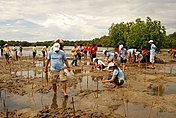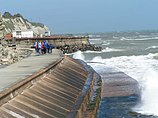
Back تكيف مع تغير المناخ Arabic জলবায়ু পরিবর্তন অভিযোজন Bengali/Bangla ڕاھاتن بە گۆڕانی ئاووھەوا CKB Adaptace na globální oteplování Czech Ymaddasu i newid hinsawdd Welsh Klimatilpasning Danish Anpassung an die globale Erwärmung German Προσαρμογή στην κλιματική αλλαγή Greek Adaptación al cambio climático Spanish Kliimamuutustega kohanemine Estonian
Climate change adaptation is the process of adjusting to the effects of climate change. These can be both current or expected impacts.[1] Adaptation aims to moderate or avoid harm for people, and is usually done alongside climate change mitigation. It also aims to exploit opportunities. Humans may also intervene to help adjustment for natural systems.[1] There are many adaptation strategies or options. They can help manage impacts and risks to people and nature. The four types of adaptation actions are infrastructural, institutional, behavioural and nature-based options.[2]: Figure 16.5 Some examples of these are building seawalls or inland flood defenses, providing new insurance schemes, changing crop planting times or varieties, and installing green roofs or green spaces. Adaptation can be reactive (responding to climate impacts as they happen) or proactive (taking steps in anticipation of future climate change).
The need for adaptation varies from place to place. Different regions must adapt differently because they each face particular sets of climate risks.[3] : 2417 For instance, coastal regions might prioritize sea-level rise defenses and mangrove restoration. Arid areas could focus on water scarcity solutions, land restoration and heat management. The needs for adaptation will also depend on how much the climate changes or is expected to change, which is different from place to place. Adaptation is particularly important in developing countries because they are most vulnerable to climate change.[4][5] Adaptation needs are high for food, water and other sectors important for economic output, jobs and incomes. One of the challenges is to prioritize the needs of communities, including the poorest, to help ensure they are not disproportionately affected by climate change.[6]: 1253
Adaptation planning is important to help countries manage climate risks. Plans, policies or strategies are in place in more than 70% of countries.[7] Agreements like the Paris Agreement encourage countries to develop adaptation plans. Other levels of government like cities and provinces also use adaptation planning. So do economic sectors. Donor countries can give money to developing countries to help develop national adaptation plans. This is important to help them implement more adaptation. Monitoring and evaluation are crucial components of adaptation efforts, ensuring that implemented strategies are effective and allowing for adjustments as needed. The adaptation carried out so far is not enough to manage risks at current levels of climate change.[8]: 20 [9] : 130 And adaptation must also anticipate future risks of climate change. The costs of climate change adaptation are likely to cost billions of dollars a year for the coming decades. In many cases, the cost will be less than the damage that it avoids.
- ^ a b IPCC, 2022: Annex II: Glossary [Möller, V., R. van Diemen, J.B.R. Matthews, C. Méndez, S. Semenov, J.S. Fuglestvedt, A. Reisinger (eds.)]. In: Climate Change 2022: Impacts, Adaptation and Vulnerability. Contribution of Working Group II to the Sixth Assessment Report of the Intergovernmental Panel on Climate Change [H.-O. Pörtner, D.C. Roberts, M. Tignor, E.S. Poloczanska, K. Mintenbeck, A. Alegría, M. Craig, S. Langsdorf, S. Löschke, V. Möller, A. Okem, B. Rama (eds.)]. Cambridge University Press, Cambridge, UK and New York, NY, USA, pp. 2897–2930, doi:10.1017/9781009325844.029
- ^ Cite error: The named reference
:02was invoked but never defined (see the help page). - ^ O'Neill, B., M. van Aalst, Z. Zaiton Ibrahim, L. Berrang Ford, S. Bhadwal, H. Buhaug, D. Diaz, K. Frieler, M. Garschagen, A. Magnan, G. Midgley, A. Mirzabaev, A. Thomas, and R.Warren, 2022: Chapter 16: Key Risks Across Sectors and Regions. In: Climate Change 2022: Impacts, Adaptation and Vulnerability. Contribution of Working Group II to the Sixth Assessment Report of the Intergovernmental Panel on Climate Change [H.-O. Pörtner, D.C. Roberts, M. Tignor, E.S. Poloczanska, K. Mintenbeck, A. Alegría, M. Craig, S. Langsdorf, S. Löschke, V. Möller, A. Okem, B. Rama (eds.)]. Cambridge University Press, Cambridge, UK and New York, NY, USA, pp. 2411–2538, doi:10.1017/9781009325844.025.
- ^ "Unprecedented Impacts of Climate Change Disproportionately Burdening Developing Countries, Delegate Stresses, as Second Committee Concludes General Debate". United Nations. 8 October 2019. Retrieved 12 December 2019.
- ^ Sarkodie, Samuel Asumadu; Ahmed, Maruf Yakubu; Owusu, Phebe Asantewaa (5 April 2022). "Global adaptation readiness and income mitigate sectoral climate change vulnerabilities". Humanities and Social Sciences Communications. 9 (1): 1–17. doi:10.1057/s41599-022-01130-7. hdl:11250/2999578. ISSN 2662-9992. S2CID 247956525.
- ^ Cite error: The named reference
:16was invoked but never defined (see the help page). - ^ Cite error: The named reference
:2was invoked but never defined (see the help page). - ^ Cite error: The named reference
:3was invoked but never defined (see the help page). - ^ Cite error: The named reference
:10was invoked but never defined (see the help page).
© MMXXIII Rich X Search. We shall prevail. All rights reserved. Rich X Search



